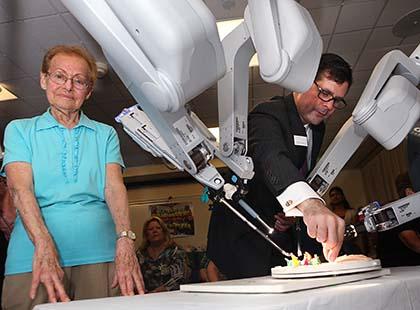By Howard Koplowitz
Two northeast Queens women who underwent surgery to remove polyps by a doctor using a robot got a chance to try their hands at the device Monday.
Bayside resident Irene Borovoy, 83, had surgery to remove a polyp two weeks ago with her doctor using the so-called da Vinci surgical system.
“I’m in the 21st century and I want to have 21st-century surgery,” Borovoy said.
Advantages to using the da Vinci robot include smaller incisions than standard surgery, shorter hospital stays, less blood loss and less pain.
“The incisions are half an inch, so patients do very well,” said Dr. Diana Contreras, director of Long Island Jewish Medical Center’s Division of Gynecologic Oncology. “They recover faster and they don’t have to be in the hospital long.”
After undergoing surgery June 9, Borovoy said she was out of LIJ the next day and back to doing the things she enjoys: walking, food shopping and eating at restaurants.
Borovoy tried out the da Vinci robot Monday, which surgeons use to make small incisions with tiny surgical instruments that they manipulate while looking through a laparoscope, or a surgical telescope.
The da Vinci system helps the surgeons achieve greater precision, increased range of motion, improved dexterity, enhanced visualization and improved access.
“Unbelievable,” Borovoy said after trying out the robot, which patients used by manipulating the arms to put rings on small cones. “I couldn’t believe you could have a control like that.”
Anne McNamee, a 65-year-old Douglaston resident, had her hysterectomy performed last Thursday using the da Vinci and was out of the hospital the next day.
“I feel fabulous,” she said. “I’m just happy that it’s over and it was successful.”
Contreras also operated on McNamee, who said the doctor made her feel “very comfortable” and she was not nervous during the procedure.
McNamee joked that she became an expert at using the da Vinci.
“I think I can take her job away now,” she said of Contreras. “It’s a fantastic surgery for every woman.”
Contreras said 80 percent to 90 percent of her patients are now undergoing surgery using the robot.
“Minimally invasive surgery is the way we want to operate on them,” she said. “We have great results.”
Contreras said the robot is also used for hernia repair, cardiac surgery, urology and prostate cancer operations.
Reach reporter Howard Koplowitz by e-mail at hkoplowitz@cnglocal.com or by phone at 718-260-4573.



































